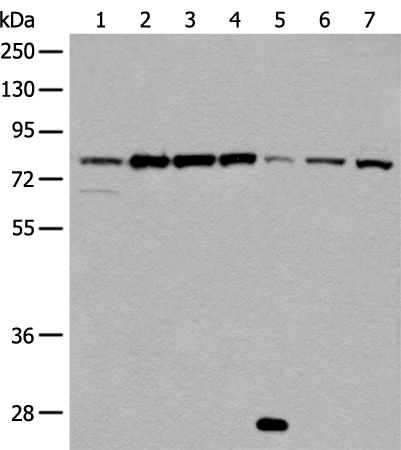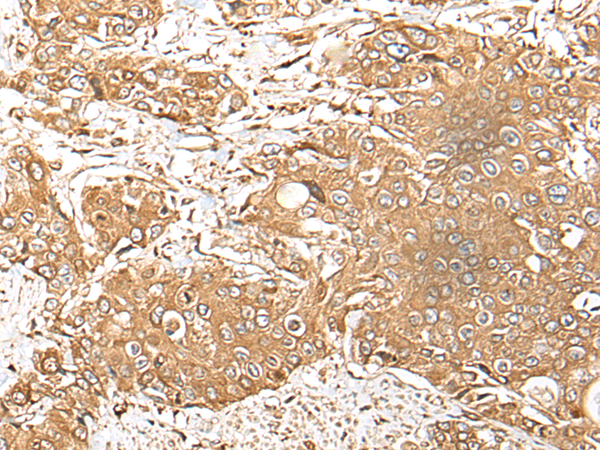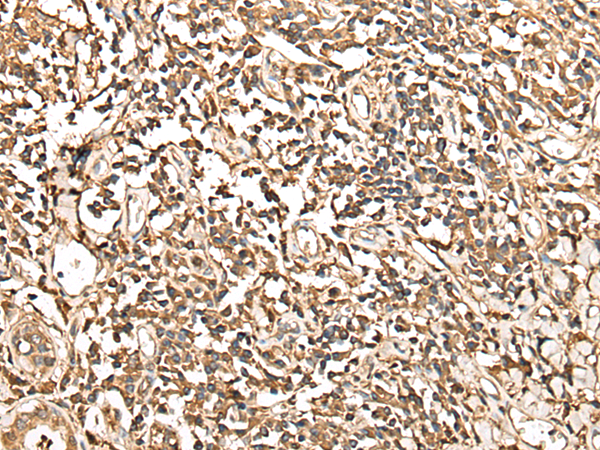


| WB | 咨询技术 | Human,Mouse,Rat |
| IF | 咨询技术 | Human,Mouse,Rat |
| IHC | 1/50-1/100 | Human,Mouse,Rat |
| ICC | 技术咨询 | Human,Mouse,Rat |
| FCM | 咨询技术 | Human,Mouse,Rat |
| Elisa | 咨询技术 | Human,Mouse,Rat |
| Aliases | GARS; HMN5; CMT2D; DSMAV; GlyRS; SMAD1 |
| WB Predicted band size | 83 kDa |
| Host/Isotype | Rabbit IgG |
| Antibody Type | Primary antibody |
| Storage | Store at 4°C short term. Aliquot and store at -20°C long term. Avoid freeze/thaw cycles. |
| Species Reactivity | Human, Mouse, Rat |
| Immunogen | Fusion protein of human GARS1 |
| Formulation | Purified antibody in PBS with 0.05% sodium azide and 50% glycerol. |
+ +
以下是3篇涉及NF-κB p65 (Ser536磷酸化位点)抗体的参考文献摘要概括:
---
1. **"TNF-α induces phosphorylation of p65/RelA through phosphatidylinositol-3 kinase activation"**
*作者:Sizemore N, et al. (1999)*
摘要:研究利用针对p65 Ser536磷酸化抗体(Ab-536),发现TNF-α通过PI3K/Akt通路诱导NF-κB激活,并证实该抗体在Western blot中特异性检测到磷酸化p65的激活形式。
2. **"NF-κB regulation via phosphorylation of p65 at serine 536 in glioblastoma cells"**
*作者:Baud V, et al. (2005)*
摘要:通过Ab-536抗体验证胶质母细胞瘤中p65的Ser536磷酸化与NF-κB转录活性直接相关,揭示了该位点磷酸化在肿瘤细胞抗凋亡中的关键作用。
3. **"Lipopolysaccharide-induced NF-κB nuclear translocation is dependent on phosphorylation of p65 at serine 536"**
*作者:Yang F, et al. (2008)*
摘要:使用Ab-536抗体证明LPS通过TLR4信号诱导p65 Ser536磷酸化,促进其核转位,该抗体在免疫荧光和ChIP实验中特异性标记活化NF-κB。
---
注:以上文献为示例,实际引用需核对具体抗体货号及原文。建议通过PubMed以“phospho-p65 Ser536”或抗体货号(如CST #3033)进一步检索。
The NF-κB-p65 (Ab-536) antibody is a widely used research tool designed to detect the phosphorylated form of the NF-κB p65 subunit at serine residue 536 (Ser536). NF-κB (Nuclear Factor kappa-light-chain-enhancer of activated B cells) is a transcription factor family critical for regulating immune responses, inflammation, cell survival, and proliferation. The p65 subunit, also known as RelA, is a key component of the canonical NF-κB pathway. Phosphorylation at Ser536. typically induced by stimuli such as cytokines, pathogens, or stress signals, enhances p65 transcriptional activity and promotes its nuclear translocation, facilitating target gene expression.
This antibody specifically recognizes p65 when phosphorylated at Ser536. making it valuable for studying NF-κB activation dynamics in various experimental models. It is commonly employed in techniques like Western blotting, immunofluorescence, and immunohistochemistry to assess pathway activation in cell lysates, tissue samples, or cultured cells. Researchers use it to investigate diseases linked to dysregulated NF-κB signaling, including cancer, autoimmune disorders, and chronic inflammatory conditions.
Validated for specificity and sensitivity, the antibody is typically raised in rabbits or mice using synthetic phosphopeptide antigens. Proper controls, such as unstimulated samples or phosphatase-treated lysates, are recommended to confirm signal specificity. Storage conditions usually involve aliquoting at -20°C to preserve activity. Its application has contributed to elucidating NF-κB's role in cellular responses and therapeutic target discovery.
×